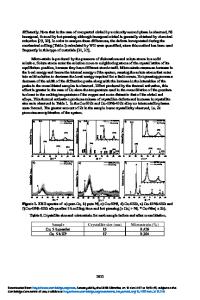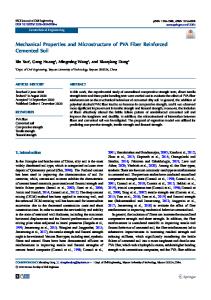Microstructure and mechanical properties of novel ternary electroconductive ceramics
- PDF / 8,084,267 Bytes
- 10 Pages / 612 x 792 pts (letter) Page_size
- 112 Downloads / 294 Views
Electroconductive ceramic composites, constituted of an insulating matrix (a composite AlN-SiC) containing 30 vol% of an electroconductive phase (MoSi2, ZrB2, or ZrC), were densified through hot-pressing. Microstructure and mechanical properties were compared to those of the AlN-SiC matrix material. All the ternary composites are good electrical conductors, with resistivities in the range 0.3 × 10−3 to 4 × 10−3 ⍀·cm. Room temperature properties are improved by the addition of the electroconductive particles. Strength and toughness measurements at high temperature show that MoSi2-containing composite is stable up to 1300 °C (strength 611 MPa, toughness 3.7 MPa·m1/2), whereas ZrB2-containing composite is stable up to 1000 °C. ZrC-containing composite is not suitable for high-temperature applications due to poor oxidation resistance.
I. INTRODUCTION
The development of ceramics that display good hightemperature structural properties and that are also electrical conductors is of great interest for a wide range of applications. Moreover, for specific uses, it is mandatory to tailor the electrical conductivity over a certain range of resistivities, typically from 102 to 10−3 ⍀·cm, without affecting the mechanical properties. Ceramic composites containing a variable amount of electroconductive phase could fulfill this requirement. This paper is focused on the microstructural and mechanical characterization of new ternary electroconductive materials in the systems: AlN-SiC-MoSi2, AlN-SiCZrC, and AlN-SiC-ZrB2, where AlN is the major constituent. AlN and SiC are very important structural ceramics, which have recently been combined and studied as very promising composites in terms of mechanical properties.1–5 The addition of hard and stiff intermetallic phases such as MoSi2, ZrC, and ZrB2 not only makes these ternary composites electroconductive but should also have the function of improving some mechanical properties, such as Young’s modulus, hardness, and fracture toughness. MoSi2 has been combined with many structural ceramics such as SiC, SiAlON, Al2O3, AlN, ZrO2, or Si 3 N 4 6–9 and significant improvements have been observed in terms of strength, toughness, and hightemperature properties. In addition to high electrical
a)
Address all correspondence to this author. e-mail: [email protected] DOI: 10.1557/JMR.2004.0428 J. Mater. Res., Vol. 19, No. 11, Nov 2004
http://journals.cambridge.org
Downloaded: 30 Mar 2015
conductivity, MoSi2 possesses a high melting point (about 2030 °C) and excellent oxidation resistance.10 Ternary composites, combining SiC and MoSi2 with a nitride ceramic, were found to be particularly promising for applications in heaters and igniters11 due to their suitable electrical characteristics that can be tailored by means of an appropriate SiC/MoSi2 ratio. ZrB2 and ZrC belong to the class of the so-called ultrarefractory materials, having melting points of 3000 and 3540 °C, respectively. ZrB2 displays a number of unique properties including hardness, high thermal and electrical conductivity, and c
Data Loading...










